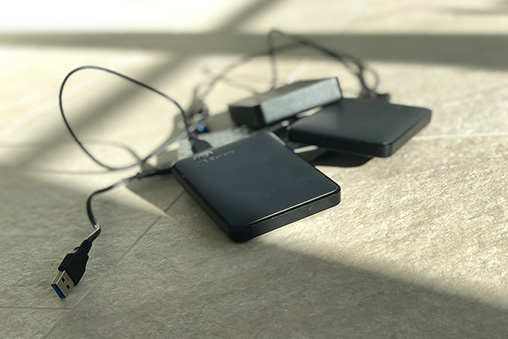Newsletter archive
State of Duplicate Annihilator – part 47
- Improvements to Duplicate Annihilator.
- AI in Photos Finder.
State of Duplicate Annihilator – part 46
- Duplicate Annihilator for Photos v9
- AI Classroom.
State of Duplicate Annihilator – part 45
- GPTEverything.
- AI coming to Duplicate Annihilator and Photos Finder.
State of Duplicate Annihilator – part 44
- Introducing Photos Clicker.
- Improvements to Photos Finder.
- Photos and People
State of Duplicate Annihilator – part 43
- Introducing Photos Finder.
- macOS 13 Ventura feature "Copy Subject" explained.
State of Duplicate Annihilator – part 42
- Photos 8 – how to set up a shared library
State of Duplicate Annihilator – part 41
- New features in Photos 8
State of Duplicate Annihilator – part 40
- Duplicate Annihilator for Photos v8 released
- How to search, filter, suggest and “facet” your search in Photos.
State of Duplicate Annihilator – part 39
- How to work with People/faces?
State of Duplicate Annihilator – part 38
- Metadata, what is it and how do I use and edit it?
State of Duplicate Annihilator – part 37
- Introducing Duplicate Annihilator 7.5.0 including fix for iCloud and missing files.
State of Duplicate Annihilator – part 36
- Introducing Duplicate Annihilator v7 including copy metadata from duplicates to originals.
- Smart albums for missing people no longer working
- Photos 7 and Live Text
State of Duplicate Annihilator – part 35
- Preserve folder and album structure as keywords
State of Duplicate Annihilator – part 34
State of Duplicate Annihilator – part 33
State of Duplicate Annihilator – part 32
State of Duplicate Annihilator – part 31
State of Duplicate Annihilator – part 30
State of Duplicate Annihilator – part 29
State of Duplicate Annihilator – part 28
State of Duplicate Annihilator – part 27
State of Duplicate Annihilator – part 26
State of Duplicate Annihilator – part 25
State of Duplicate Annihilator – part 24
State of Duplicate Annihilator – part 23
- Working with Duplicate Annihilator for Photos – part 3
State of Duplicate Annihilator – part 22
- Working with Duplicate Annihilator for Photos – part 2
State of Duplicate Annihilator – part 21
- macOS 10.5 Catalina, Photos 5 and Duplicate Annihilator v4
- Working with Duplicate Annihilator for Photos – part 1
State of Duplicate Annihilator – part 20
State of Duplicate Annihilator – part 19
State of Duplicate Annihilator – part 18
State of Duplicate Annihilator – part 17
State of Duplicate Annihilator – part 16
- Duplicate Annihilator – HEIC format support
- What is HEIC?
State of Duplicate Annihilator – part 15
State of Duplicate Annihilator – part 14
State of Duplicate Annihilator – part 13
State of Duplicate Annihilator – part 12
State of Duplicate Annihilator – part 11
State of Duplicate Annihilator – part 10
State of Duplicate Annihilator – part 9
State of Duplicate Annihilator – part 8
State of Duplicate Annihilator – part 7
State of Duplicate Annihilator – part 6
State of Duplicate Annihilator – part 5
State of Duplicate Annihilator – part 4
State of Duplicate Annihilator – part 3
State of Duplicate Annihilator – part 2
State of Duplicate Annihilator – part 1
Dear friend,
My name is Anders and I’m the CEO of Brattoo Propaganda Software. In my last email I wrote about Memories in Photos and some of the hidden background processes of Photos. I get a lot of questions about backup and it is certainly is a good topic. How do I make sure that my precious photos are not lost over time? In this letter I will take a break from features of Photos and focus on how to keep your photos safe and restorable. I will reference to third party products and I do that since those are the products that I use myself.
Why backup?
Some may say that a backup is not necessary. Some may argue that if you use iCloud or Google Drive or Dropbox then your files are safe. There are many aspects to think about when it comes to backup. First, we need to think about what can happen. Hardware can fail, or we can have the misfortune of theft or fire. We can even be victims of evil hackers and what is called ransomware. Bottom line; keep a backup!
Ask yourself this question: what if I lost this computer right now, would I be able to recover everything that I hold dear on it? If the answer is no then consider a backup.
Physical threats
A physical threat could be a failed hard drive. Hard drives are fragile devices and they all fail eventually as everything that has moving parts does. Sure there are Solid State Drives that do not have moving parts but even those fail from time to time. Then we have thefts. I have personally been the victim of burglary twice. Both times I had a backup on an external hard drive and guess what, they took the backup drive as well. These days I keep more than one backup and not only a local one.
The same goes with fire. When people are asked what they would save if they could only save one thing in case of fire, people tend to say that they would save a photo album. Photos are important, they are proof and memories and that is understandable. Well, today your photos are on your computer so in other words, save your computer. But that might not always be possible. So again, keep a backup!
Digital threats
A digital threat is something that affects your files. It could be a user failure when a folder of precious files are accidentally dragged to the trash and then the trash is emptied. It could be a malicious software that deletes or overwrite files. It could also be some kind of ransomware or similar.
Now, deleting files is easy to understand but what is ransomware? It is a fairly new thing that is quite ugly. A software encrypts the files on your hard drive and then shows you a message that you have to pay for the files to be decrypted. When this happens you will not be able to decrypt the files yourself or by help by the local expert. Those files will be heavily encrypted using super safe methods, they simply can not be decrypted without knowing the secret key. This is called ransomware. Be careful.
Then we have another version of ransomware. You might be using iCloud and Back to My Mac or Find my iPhone which are great iCloud services making it possible to lock down, erase or track your Mac, iPhone or iPad. Well, imagine that someone else got their hands on your iCloud password. That person can use the same feature to lock down your devices and demand a ransom for them to unlock your computer or iPhone. When considering this you will probably agree with me when I say that you should have a good password.
A good password does not have to be a complex sequence of strange characters, it is better to have a password that is long but simple to remember since that will make it less likely that you need to write it down and when a computer tries to break it it will have to try many more combinations making it less likely to be broken. As the author of the comic: https://xkcd.com/936/ puts it – for years we’ve successfully trained everyone to use passwords that are hard for humans to remember, but easy for computers to guess.
To make passwords safer many services such as Google, and now also iCloud, offer what is called a two factor authentication. This is a great step when it comes to preventing hackers from using your password. To explain, it simply it works like this. When you enter your password a code is sent to one of your devices, it could be a sms to your phone. Then the service that you are trying to log into asks for that code. This makes it much harder for someone to log into your iCloud account since they will also need physical access to one of your devices to get that extra code.
Cloud storage
You might have heard of “the Cloud” and wondered what it is. The Cloud simple refers to storage located on servers elsewhere. The Cloud has many vendors and can be used for many things. One obvious thing is for storage. You might be using iCloud for your Photos Library or even for your documents. Other similar services are Dropbox and Google Drive where you store files in a folder on your computer and the contents of that folder is synced up to the Cloud and to any other devices or computers that use the same account.
Those Cloud services are great but they are not a real backup. So why are they not backup? They sync your files to the cloud which also means that if you are the victim of ransomware then the encrypted files will also be synced and replace the unencrypted files in the Cloud as well. Or if you delete a file, then it will be deleted from the Cloud as well. Granted, Dropbox, Google Drive and iCloud all have a 30 days recovery backup so you can restore deleted, corrupted or encrypted files during that period. After the 30 day period older versions are constantly deleted. This means that you need to restore files from those services pretty quickly after loosing them locally.
Therefore, Cloud storage is not the perfect backup but it can be helpful.
Local backup
A local backup can be an external hard drive that you either backup to continuously either with Time Machine which is a backup solution built in to macOS or by a third party software such as SuperDuper or CrashPlan. A local backup can also be made to a NAS (a hard drive connected to your local network) with about the same stability and performance as a usb disk directly connected to your computer.
The obvious advantage with a local backup is that it is easy to verify, and it is fast both for backup and recovery. The disadvantages are equally obvious, they will be destroyed in a fire, they might be stolen or the hardware fail. Also, ransomware can encrypt local backups as well.
Remote backup
Backup to a remote location has many benefits, especially when it comes to security and availability in case of damaged hardware, theft, fire, deleted files and ransomware. It is dependent on your bandwidth and backing up all data online will take some time, but if you use a backup program/service like CrashPlan then only the initial backup will take considerable time. The backup will be smoother since only changed files will be backed up leaving you with a full online backup. It will contain a full history of all changes made to your files and every file can be recovered at any time from any device.
A remote backup can be made either to a friend’s place or to a cloud based backup. Personally I use CrashPlans online storage since their storage is much more fail proof, monitored and protected than any friend’s home would be.
Privacy and remote backup?
A fair question would be: is my remotely backed up data safe from prying eyes? Well, that depends on which service you use and how they work. Personally I prefer the data stored remotely to be encrypted. Then only I have they key to unlock it. Since the data is transferred over the Internet, I prefer it to be encrypted and then decrypted locally on my computer. That way no one can listen to the traffic from my computer and nobody can look at my files wherever they are stored.
So backup in Summary
Most of us value our data so a backup is a good idea and when you actually need it you will be very happy that you have it. Depending on your needs, consider the different options; local and remote, synced cloud services, full backup or partial backup. If you feel like discussing it more simply reply to this email.
Personally I use CrashPlan for remote backup, SuperDuper for an extra local full backup and Time Machine since it can be convenient from time to time. It is important to mention that I’m not sponsored by any of these products and I’m not getting payed for mentioning them. I simply like them and use them.
When everything fails
When you have deleted that important file and for some reason you have no backup and the panic gets to you… well, there is a solution!. In most case deleted files can be recovered with special software. Personally I have used Disk Drill. Since it is kind of expensive I have managed to get you a 40% discount! Hopefully you will never need it.
Upgrades
Finally I would just like to tell you that our upgrade discount for Duplicate Annihilator for Photos is still available. For only $4.95 you can upgrade any old Duplicate Annihilator license to Duplicate Annihilator for Photos and for just one dollar ($1.00) more you can upgrade any old Duplicate Annihilator license to the Duplicate Annihilator Toolbox including a family pack! This means that you get five licenses for you and your family for all versions of Duplicate Annihilator including iPhoto, Aperture, iOS and Photos for only $5.95.
Get the upgrade from: https://upgrade.brattoo.com
Thank you for your time, I hope that you found this email informative. If you have any feedback, suggestions or ideas the please reply to this email. I read all emails and reply to them in person.
Best Regards,
Anders, CEO and Founder, Brattoo Propaganda Software
Duplicate Annihilator

Duplicate Annihilator is one of the oldest and most competent duplicate detection softwares for photos on the market. It's available for Photos, iPhoto, Aperture and iOS.
Photos Finder

Are your photos scattered everywhere and getting them into one Photos Library might seem like an impossible task. Photos Finder makes this task as simple as the click of a button.
Free software

They say there is no such thing as a free lunch but we have free apps. Built for our customers, based on personal requests and completely free of charge. Bon appétit!
Support

Sometimes everything seems to complex and daunting but everyone needs a little help now and then or at least a nudge in the right direction to get back on track. This is where you find it.
- © Untitled
- Design: HTML5 UP